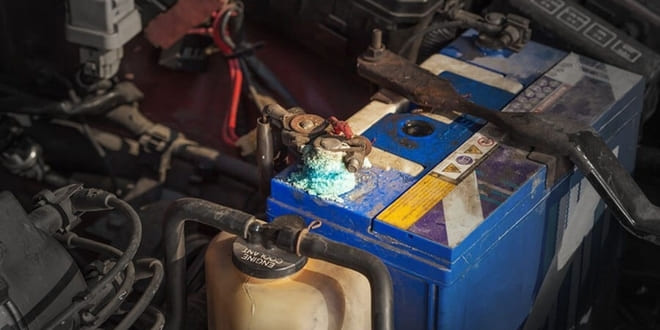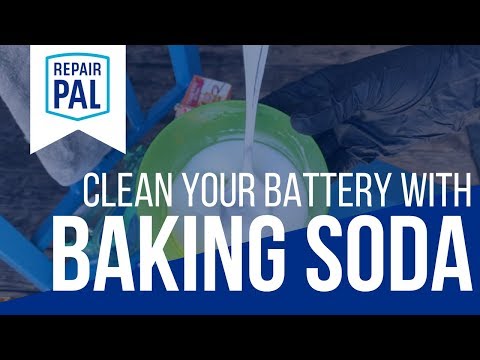
Do you found a greenish or whitish substance in the car battery terminal after you open the hood of your vehicle? If the answer is YES, your car battery has been affected by corroding.
A car battery plays a vital role in the automobile industry because the smooth operation of a car depends on the battery status. Also, a battery controls the car’s AC operation, and the headlight turns on/off, ignition, and many other tasks.
Car battery corrosion is a common problem in every car. But what is the solution to this? Why do car batteries corrode?
Read this article; I have covered every aspect related to car battery corrosion.
Causes of Car Batteries Corrosion
Different reasons are responsible for car battery corrosion. Below are the most common reasons discussed.
1. H2 gas leakage
A car battery converts the acid into an electrical current. Chances are there, hydrogen gas leaked into the battery and entered the atmosphere. Then it creates a reaction with other atmosphere substances, and thus the battery terminal gets corroded.
You can diagnose different battery problems depending on which way it is formed. If you find the corrode in the negative terminal portion, be sure it has happened because of the undercharging issue. If the corrode is in the positive terminal portion, it happens due to overcharging.
Most of the time, you will find the corrode in the negative terminal area because car batteries face undercharging problems most.
2. Leakage of electrolyte
Leakage of electrolyte problems will be found mostly in lead-acid batteries. Over time, electrolytes of a lead-acid battery can leak and gather in the terminal of a battery. Leaking of electrolytes will increase if you overfill the water of the car battery.
3. Copper clamps corrosion
The conductivity of copper is great, and it is a corrode-resistant substance. However, copper sulfate is produced in the copper terminals when an electrical current passes through them, which leads to the corrosion of the battery terminals. A bluish substance at the copper terminal could mean copper sulfate.
Since copper sulfate is not a good conductor, this is the reason you will start facing a problem when driving your car.
4. Overfilling and overcharging
An electrolyte will leak through the vent if you overfill your car battery with water. You must not overfill the car battery with water. Also, the water level has to be sufficient enough.
Overcharging will also give you a similar problem – electronic momentum gets charged on the kinetic energy, and the terminal gets overflowed. As a result, corrosion happens.
How to get rid of Car Batteries Corrode
1. Apply a Solution of water and baking soda
If your car battery terminal gets accumulated by copper sulfate, a solution of water and baking soda will be a great option. After making the solution, take a brush. Then turn off the car’s ignition. The battery terminal needs to be removed, and remove the corrosion using the brush.
Now, pour the baking soda onto the corroded area and apply it to brush thoroughly to remove it. Once you finish cleaning the corrosion, pour some clean water on the terminals and clean the whole area. To avoid further damage, it would be best to apply some wheel bearing grease on the battery terminals. You also can choose petroleum jelly instead of grease, but petroleum jelly doesn’t last long.
2. Soda
Pour some soda on the corroded area, and then using a soft sponge, remove the corrode. If you don’t have baking soda and water in your hand, this option will help you a lot.
3. Removing heavy corrosion
If the corrosion is excessive in the terminal battery area, a water-baking soda solution and a toothbrush will deliver the best result. Detach the battery terminal first – start with the negative terminals first. Make the solution of water and baking soda in a cup. Soak the terminal in the solution and give it a rest for the next 20 minutes.
Using the toothbrush, scrub off all the corrosive materials. Once scrubbing is done, make a fresh solution again. Again soak all the materials of the battery terminal and follow the same procedure.
Lastly, use warm water to clean the battery terminal and give it air-dry or use a damp cloth to clean it. Instead of a toothbrush, you also can use a piece of sandpaper to scrub the corroded area.
Finally, apply grease or Vaseline to the terminals and reattach it. This time start reattaching to the positive part.
4. Use aspirin to revive an old battery
You can follow this process if your car battery has run out of purpose and you need one more charge to continue. Look for an aspirin tablet in your medical box; if you find one, you are the luckiest person. Pop 2 aspirin tablets into the battery and the car battery will get charged one more time.
You might be wondering how aspirin is doing this magic!
Aspirin contains acetylsalicylic acid, and once this acid makes a combination with the sulfuric acid of the battery, your car battery will get charged.
Preventive Maintenance
Charging the battery
By now, you already understand that due to overcharging or undercharging, battery terminals get corroded. So, before charging the car battery, look at the manufacturer’s manual to learn about the car battery’s right battery voltage.
If you want to prevent corrosion formation in the battery terminals, you have to comply with it.
Applying anti-corrosion sprays
Different anti-corrosive sprays are available in the market, which will help you eliminate the corrosion problem in the battery terminal.
If you think sprays are costly, you can choose grease or petroleum, or Vaseline as a solution to this problem.
Final Word
Car batteries are one of the most important components of a vehicle. The starter receives electricity from it. As a result, spark plugs receive electric signals, and the vehicle starts. A car with low battery power will show a lot of problems.
Remember to keep items such as baking soda or soda and water in your car because you don’t know when and where the battery will start showing a problem. Follow the above guideline and keep the vehicle free from any corrosion in the battery terminal.
